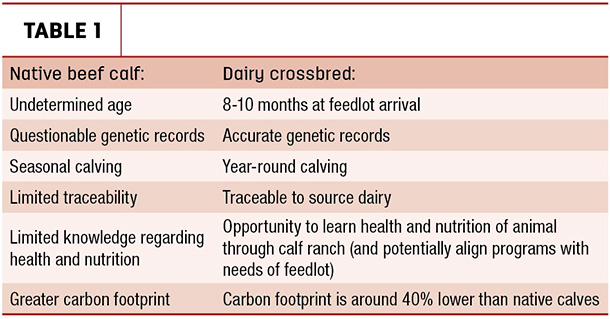“There’s an opportunity here for producers to get a higher premium for their product,” said Dr. Dale Woerner, associate and Cargill-endowed professor of animal and food sciences at Texas Tech University during a panel presentation at the 2022 Dairy Calf and Heifer Association annual conference April 13.
Woerner, who presented alongside Friona Industries’ (a cattle feeder in Texas and Kansas) Bob Sato, discussed how crossbred calves are hitting the market on the beef side of things and a few advantages dairy producers might have with their crossbred animals.
With the influx of crossbred calves to feedlots across the U.S., feedlot operators have made a few observations about these cattle. Table 1 breaks down some of the opportunities crossbred calves are bringing to the feedlots.

Due to the structure of the dairy industry and the importance of tracking animals’ records, the crossbred calves arriving at feedlots have a birthdate, accurate genetic records and are available year-round. In most cases, they can be traced back to their “home” dairy, have been on a nutrition plan and arrive with records of health events, as well as maintaining a lower carbon footprint compared with native calves.
Sato discussed the desires of consumers in the beef market and pointed out that consumers like to know where their food is coming from.
“Something the pork and poultry industries do well is track where each animal is from,” Sato said. “The dairy industry naturally does that. The beef industry is not so great at that. However, these crossbred calves are providing us with an opportunity to use that as a marketing tool.”
Another hot topic consumers are concerned about is sustainability. Crossbred calves generally have higher feed efficiency (when compared to purebred dairy calves), which lowers their environmental impact. With a significant difference in the carbon footprint between native calves and crossbred calves, there’s room for producers to market crossbred products at a higher premium.
Woerner, who has been researching this topic for the past several years, discussed the areas in which crossbred calves outperform their purebred counterparts, including taste, tenderness, marbling and quality of cuts. This has come as a bit of a surprise to most, as purebred dairy cattle loin and ribeye steaks present a darker colour and different shape at a retail display. This directly influences the consumer in the store, as a darker, strange shape is not as appealing as a bright red, regular steak shape that beef cattle produce. However, Woerner’s research showed colour and shape were less of a concern to consumers with crossbred products when compared to purebred dairy products.
These tastier alternatives give dairy producers an opportunity to make even more money from their crossbred animals.
Sire selection remains a very influential factor in the performance of crossbred products. Woerner noted that individual sire selection is more important than the general breed when it comes to producing an efficient, high-producing animal. His research suggests sire selection should emphasize fertility and birthweight, as well as muscularity and marbling, and reminds producers that beef sires selected for successful crossbreeding may not be the popular beef sires in the industry.
With a demand for sustainable, traceable products in the beef industry, the dairy industry’s crossbred calves just might be the answer.






